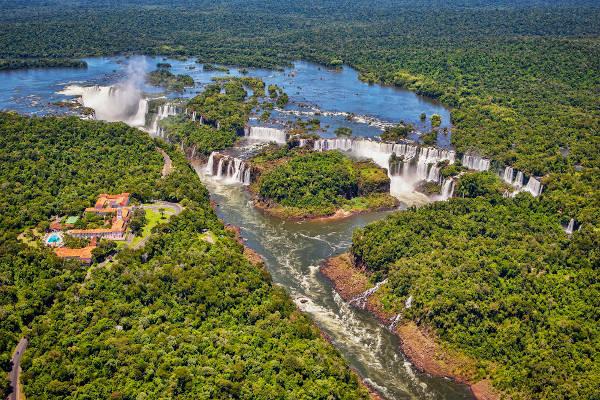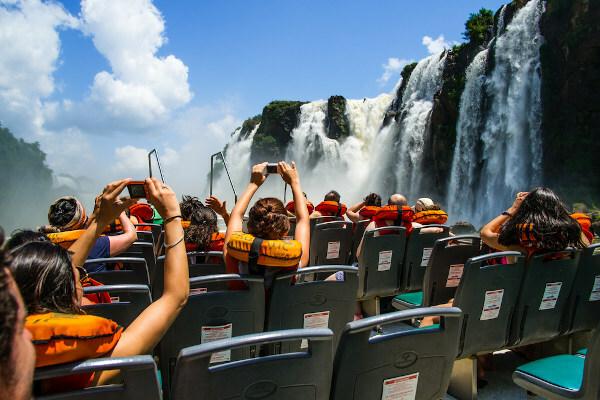To the waterfalls of Iguaçu are a set of 275 waterfalls located on the border between Brazil and Argentina. Fed by the waters of the Iguaçu River, the falls extend for 2.7 kilometers and have between 60 and 82 meters in height. In 1986 they were listed as a World Heritage Site by the Unesco and, in 2012, they entered the list of the Seven Wonders of Nature.
The Iguazu Falls have a great biodiversity preserved through the Iguaçu National Park, both on the Argentine and Brazilian sides. They are also important for the local economy, attracting millions of tourists from different parts of the world annually.
See too: Pantanal — the Brazilian biome known as the largest wetland in the world
Topics of this article
- 1 - Summary about the Iguazu Falls
- 2 - Toponymy of the Iguazu Falls
- 3 - Location of the Iguazu Falls
-
4 - Characteristics of the Iguazu Falls
- → Geography of Iguazu Falls
- → Climate of Iguazu Falls
- → Fauna and flora of the Iguazu Falls
- → Infrastructure of the Iguazu Falls
- 5 - Importance of the Iguazu Falls
- 6 - Iguazu Falls Tourism
- 7 - Iguazu Falls today
- 8 - Iguazu Falls and folklore
Summary about Iguazu Falls
Its name is derived from Tupi-Guarani, and means "big water".
They are located on the border of Brazil and Argentina.
They are part of the Iguaçu National Park, in the cities of Foz do Iguaçu and Puerto Iguazú.
They were formed on basaltic rocks characteristic of the Serra Geral formation, in the Paraná basin.
They are formed by 275 waterfalls, which make them the largest in the world in this regard, and are 2.7 kilometers long.
The falls vary in height from 60 to 82 meters, with the greatest difference observed in Garganta do Diabo, a postcard of the Iguaçu Falls.
The waters of the falls come from the Iguaçu River, and its average flow is 1500 m³/s.
The climate in the region is humid subtropical, marked by high air humidity and well-distributed rainfall throughout the year.
The Iguaçu National Park is home to a vast tropical forest, with remnants of the Atlantic Forest, and thousands of species of animals.
The falls are important for maintaining biodiversity and for the local economy due to tourism. Every year, more than 1.6 million people visit the region.
The falls are also culturally important, and their origin is told in Brazilian folklore.
The floods and increased flow of the Iguaçu Falls in 2022 contrast with the droughts of 2021, both causing a reduction in the number of visitors. The pandemic also caused a smaller flow of tourists.
Do not stop now... There's more after the publicity ;)
Toponymy of Iguazu Falls
The Iguazu Falls receive the same name given to rio Iguaçu, whose waters form the characteristic falls of this monument. The name Iguaçu is also present in several of the Brazilian cities, more specifically in Paraná, where the Iguaçu National Park is located.
The word iguaçu is derived from the Tupi-Guarani and means "big water" or "big river", in reference to the characteristics of both the river and the waterfalls that are provided by the relief local.
Location of Iguazu Falls
The Iguazu Falls are located nThe South America, more precisely on the border between the Brazil It is Argentina. It is a binational structure, located in two territories at the same time:
On the Argentine side, the Iguaçu National Park is located in Puerto Iguazú, a city in the state of Misiones.
On the Brazilian side, the park corresponds to a Federal Conservation Unit (UC) managed by the Chico Mendes Institute for Biodiversity Conservation (ICMBio). The headquarters are located in Foz do Iguaçu, a city in the western region of Paraná.
Features of Iguazu Falls

The Iguazu Falls are composed of a set of 275 waterfalls, considered the largest in the world. the waterfalls span approximately 2.7 kilometers, the largest portion of which is located in Argentine territory. On the other hand, approximately 73% of the 252,982 hectares of the Iguaçu National Park area are located in Brazilian territory.
The difference in level of the waterfalls varies between 60 and 82 meters. The largest of them corresponds to the fall known as Garganta do Diabo, which makes up the landscape that has become the postcard of the falls. See, below, other important physiographic and infrastructural characteristics of the Iguaçu Falls.
→ Geography of Iguazu Falls
The Iguazu Falls sand formed on a structure of basaltic rocks derived from lava flows that occurred in the Paraná sedimentary basin, which then gave rise to the Serra Geral formation.
The episodes of volcanism in this geological structure date back to the Cretaceous, a geological period between 144 and 64 million years ago, and the cataracts settled in a canyon located at an approximate distance of 15 km from the place where the Iguaçu River meets the Paraná River.
Along the way, the altitude at which the Iguaçu River flows goes from 200 meters to just under 90 meters, when it falls into the characteristic canyon of the natural landscape of the falls.|1| The width of its channel also changes considerably, going from 1200 meters to just 65 meters.
Under normal conditions, the flow of the Iguaçu Falls varies in the range of 1500-1750 m³/s. In droughts, however, this volume of water drops to 500 m³/s. In the flood period, characterized by the increase in the water level of the rivers, the recorded flow reaches 8500 m³/s.
→ Climate of Iguazu Falls
O climate characteristic of the region where the Iguaçu Falls occur is thesubtropical damp. As its name suggests, the air humidity is high and can reach 84%. To the rains are well distributed throughout the year, which guarantees the supply of the Iguaçu River and, consequently, of the waterfalls, and the temperatures vary between 30 ºC, in the hottest months, and 10 ºC, in the coldest months of the year.
→ Fauna and Flora of the Iguazu Falls
The Iguaçu National Park serves as a habitat for hundreds of plant and animal species. The tropical forest is the characteristic vegetation of the park. In Brazil, this forest corresponds to theAtlantic forest.
It is one of the largest remaining areas of this ecosystem in the interior of the country, hence the importance of preserving it. According to ICMBio, the flora of the park is composed of 700 different plant species, including some endangered species.

The fauna of the Iguaçu National Park is composed of more than 1500 species of animals, among mammals, birds, reptiles, fish, amphibians and invertebrates. Check the table below for some animals that can be found in the conservation unit.
Jaguar |
pit viper |
otter |
raccoon |
toucan |
woodpecker |
butterfly |
broad-snouted alligator |
heron |
anteater |
capuchin monkey |
macuco |
→ Infrastructure of Iguazu Falls
Earlier we saw that the Iguaçu Falls are inside the Iguaçu National Park. On the Argentine side, the park was created in 1934, while in Brazil its establishment took place in 1939. Access to the falls can be done from both sides, although proper documentation is required in case of crossing from Brazil to Argentina.
There are two important airports in the cities closest to the access to this natural site., one Argentinian and one Brazilian, through which foreign visitors can arrive more easily. They are the Foz do Iguaçu International Airport and the Cataratas del Iguazú International Airport, in the Argentine city of Puerto Iguazú.
One train in Argentina, the Ecological Train of the Tropical Forest, makes a journey inside the forest and in important points of the Falls do Iguaçu, approaching areas such as Garganta do Diabo, being a very useful infrastructure for visitors. Close to the waterfalls, lookouts and a walkway were installed to allow greater public access and a better view of the formed landscapes.
Read too: Amazon Basin — the largest river basin in the world
Importance of Iguazu Falls
The importance of the Iguazu Falls is environmental, cultural and economic. As we learned, they are part of a region of great biodiversity, where the Atlantic Forest has a high degree of preservation.
Some of the species that live in that area today are threatened with extinction, which is why it is very significant that the park is a conservation unit. In 1986, Unesco listed the Iguazu Falls as a Natural World Heritage Site. In 2012, they became part of the list of the Seven Wonders of Nature.
Culturally and economically speaking, the Iguaçu Falls move a local economic circuit based on the tourist activities performed in the National Park and nearby cities, attracting tourists from all countries.
Iguazu Falls Tourism

tourism is one of the main economic activities for the municipalities that are home to the Iguaçu Falls. It is estimated that 1.6 million Brazilian and foreign visitors visit the falls every year, generating millions of dollars in revenue. The grandeur of the waterfalls and the beautiful natural landscapes found in the Iguaçu National Park, both in Brazil and Argentina, are the aspects responsible for this great interest.
Once there, tourists can go on trails, guided walks, get to know the forest through the train that mentioned, and even venture to the viewpoints and walkways that are very close to the falls of water. There is also a traditional boat ride that takes groups of people into the canyon, which guarantees a complete visiting experience.
Iguazu Falls today
The pandemic of Covid-19 affected tourist trips to the Iguazu Falls due to the closure of borders and restrictions imposed by health authorities.
In addition, a severe drought affected part of the South region of Brazil in 2021 and significantly reduced the flow of the falls, transforming the natural landscape and generating a decreasedthe flow of visitors to national parks.
The 2022 scenario, however, was the opposite, but with a similar impact. The large volume of rain that hits the southern region of the country has caused rivers to flood, especially the Iguaçu River, whose source is located in Curitiba (PR).
Due to this, the average flow of wataratas increased more than 10 times and reached the mark of 13 million liters per second. This led to closure temporary of the catwalks and of the lookouts due to the risk that the intense flow of water offers to visitors.
Iguazu Falls and Folklore
The cultural richness of the Iguaçu Falls encompasses its close connection with native Brazilian peoples and national folklore. One of the most famous stories of Brazilian folklore tells how the falls came about.
According to this story, on the banks of the Iguaçu River lived an indigenous people, the Caingangues, who deposited their faith in the god M'Boi, son of Tupã who had the form of a serpent. Naipi, daughter of the chief of one of the tribes that lived there, was known for her beauty, such that the waters of the rivers stopped when she looked at them.
A young warrior named Tarobá fell in love with her and took advantage of a moment of celebration and distraction during Naipi's consecration to flee with the girl down the river. M'Boi, enraged by the escape, entered the earth and caused a huge crack in the ground, where a series of waterfalls formed.
The vessel on which Naipi and Tarobá were fleeing disappeared into the crevice created, and the youths were punished. Naipi was transformed into a rock and Tarobá into a palm tree that hangs over the Devil's Throat, from where the serpent watches over them eternally.|2|
Grades
|1| SALAMUNI, R.; SALAMUNI, E.; ROCHA, L.A.; ROCHA, A.L. The Iguazu National Park. In: SCHOBBENHAUS, C.; CAMPOS, D.A.; QUEIROZ, E.T.; WINGE, M.; BERBERT-BORN, M. (Edit.) Geological and Paleontological Sites of Brazil, 1999. Available here.
|2| CATARATAS GROUP. The Legend of the Falls. Available here.
By Paloma Guitarrara
Geography Teacher
Do you know Argentina, an important country in South America? Get to know the main geographical aspects of this territory and learn curiosities about this country.
The Iguaçu Falls, in the west of the state of Paraná, have been closed since this Wednesday, the 12th. The walkways and lookouts near the falls were closed.
Do you know how to differentiate a natural landscape from a cultural landscape? Click and understand these concepts better. See also examples in Brazil and around the world.
Meet Paraná! Read here a little more about the characteristics of this state in southern Brazil, such as its geographic aspects, economy, population and culture.


